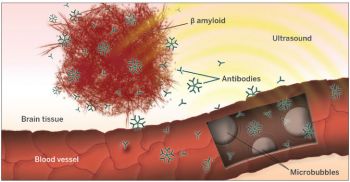New results published this week in Science Translational Medicine suggest that focused ultrasound might hold a key to providing a non-invasive, non-pharmaceutical therapy to treat Alzheimer’s disease.
 The work of Jürgen and Gerhard Leinenga from the Queensland Brain Institute in St. Lucia, Australia, demonstrated that focused ultrasound in combination with microbubbles, and applied in a scanning method to treat the entire brain, reduced the number and volume of amyloid plaques in an Alzheimer’s disease mouse model. This work validated previous results by Kullervo Hynynen, Isabelle Aubert, and colleagues at Sunnybrook Research Institute in Toronto, Canada, who were the first to present data suggesting the benefit of FUS and microbubbles to open the blood brain barrier and reduce the plaque burden in an AD model. The group used a different AD model and took the research one step further to demonstrate improved memory in FUS-treated animals. This is an exciting development for the field and further supports the potential of FUS for treatment of Alzheimer’s disease.
The work of Jürgen and Gerhard Leinenga from the Queensland Brain Institute in St. Lucia, Australia, demonstrated that focused ultrasound in combination with microbubbles, and applied in a scanning method to treat the entire brain, reduced the number and volume of amyloid plaques in an Alzheimer’s disease mouse model. This work validated previous results by Kullervo Hynynen, Isabelle Aubert, and colleagues at Sunnybrook Research Institute in Toronto, Canada, who were the first to present data suggesting the benefit of FUS and microbubbles to open the blood brain barrier and reduce the plaque burden in an AD model. The group used a different AD model and took the research one step further to demonstrate improved memory in FUS-treated animals. This is an exciting development for the field and further supports the potential of FUS for treatment of Alzheimer’s disease.
Read the article from Science.
Read the abstract.
Illustration Source: Emmanuel Thevenot/Lab of Isabelle Aubert; Cour of Sunnybrook Research Institute
